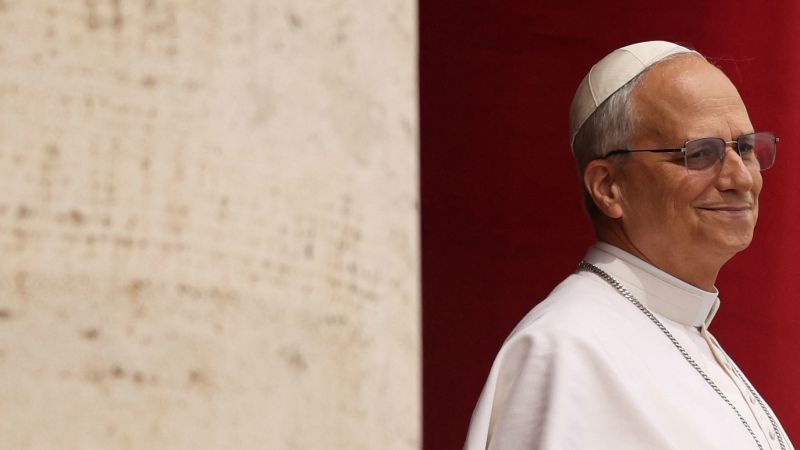The Papacy Of Leo XIII: Building Bridges And Implementing Reform

Welcome to your ultimate source for breaking news, trending updates, and in-depth stories from around the world. Whether it's politics, technology, entertainment, sports, or lifestyle, we bring you real-time updates that keep you informed and ahead of the curve.
Our team works tirelessly to ensure you never miss a moment. From the latest developments in global events to the most talked-about topics on social media, our news platform is designed to deliver accurate and timely information, all in one place.
Stay in the know and join thousands of readers who trust us for reliable, up-to-date content. Explore our expertly curated articles and dive deeper into the stories that matter to you. Visit Best Website now and be part of the conversation. Don't miss out on the headlines that shape our world!
Table of Contents
The Papacy of Leo XIII: Building Bridges and Implementing Reform
Pope Leo XIII (1878-1903) remains a significant figure in Catholic history, remembered not only for the length of his papacy but also for his pragmatic approach to navigating the complexities of the late 19th century. His reign saw a concerted effort to bridge the gap between the Church and modern society, while simultaneously implementing crucial internal reforms. This article explores the key aspects of his papacy, highlighting his enduring legacy.
A Response to Modernity:
The late 19th century was a period of immense social and political upheaval. The rise of nationalism, industrialization, and socialist ideologies posed significant challenges to the Catholic Church. Leo XIII, recognizing this, adopted a strategy of engagement rather than outright condemnation. His encyclical Rerum Novarum (1891), often considered his magnum opus, addressed the social question arising from industrialization. This landmark document advocated for the rights of workers, condemned the excesses of capitalism, and championed the dignity of labor. It's a testament to his understanding of the need for the Church to adapt to the changing social landscape, a crucial aspect often overlooked in discussions of his papacy. Rerum Novarum remains highly influential today, shaping Catholic social teaching and inspiring countless social justice initiatives. You can find the full text of Rerum Novarum online through various Catholic resources.
Promoting Dialogue and Reconciliation:
Leo XIII also focused on fostering better relations with other Christian denominations and even with non-believers. His diplomatic efforts aimed at healing the schism between the Catholic Church and the Eastern Orthodox Churches, though not fully successful, showcased his commitment to ecumenism. This proactive approach to interfaith dialogue was groundbreaking for its time and helped to set the stage for future ecumenical initiatives within the Catholic Church. Understanding his diplomatic efforts requires delving into the historical context of religious tensions in the 19th century.
Internal Reforms and Modernization:
Beyond his external engagement, Leo XIII also initiated internal reforms within the Church. He established new dioceses and missionary territories to meet the growing needs of the expanding Catholic population, particularly in newly colonized regions. He also focused on revitalizing religious orders and promoting education, establishing institutions and seminaries to train a new generation of priests prepared to address the challenges of the modern world. This focus on education and the training of clergy reflects a long-term vision for the Church's future.
Challenges and Criticisms:
Leo XIII’s papacy wasn’t without its challenges. His efforts at reconciliation were not always met with success, and he faced significant opposition from conservative elements within the Church resistant to his modernizing initiatives. Furthermore, the rise of anti-clericalism in several European nations posed ongoing difficulties for the Church. Despite these challenges, his commitment to addressing the social issues of his time and modernizing the Church's approach remains a significant contribution to Catholic history.
A Lasting Legacy:
Pope Leo XIII’s papacy represents a pivotal moment in the history of the Catholic Church. His pragmatic approach, his commitment to social justice as demonstrated in Rerum Novarum, and his attempts at ecumenical dialogue continue to inspire theologians, policymakers, and social activists today. His legacy is one of adaptation, engagement, and a persistent effort to reconcile faith with the realities of a rapidly changing world. Further research into his encyclicals and writings provides a deeper understanding of his complex and multifaceted papacy. Understanding this pivotal era in Catholic history is crucial for comprehending the Church's trajectory in the 20th and 21st centuries.

Thank you for visiting our website, your trusted source for the latest updates and in-depth coverage on The Papacy Of Leo XIII: Building Bridges And Implementing Reform. We're committed to keeping you informed with timely and accurate information to meet your curiosity and needs.
If you have any questions, suggestions, or feedback, we'd love to hear from you. Your insights are valuable to us and help us improve to serve you better. Feel free to reach out through our contact page.
Don't forget to bookmark our website and check back regularly for the latest headlines and trending topics. See you next time, and thank you for being part of our growing community!
Featured Posts
-
 The Della Maddalena Fight A Disappointment For Fans Or A Masterclass
May 13, 2025
The Della Maddalena Fight A Disappointment For Fans Or A Masterclass
May 13, 2025 -
 Milwaukee Fire Disaster Four Dead Hundreds Displaced From Homes
May 13, 2025
Milwaukee Fire Disaster Four Dead Hundreds Displaced From Homes
May 13, 2025 -
 Bbc News Crews West Bank Filming Disrupted By Tense Encounter With Sanctioned Settler
May 13, 2025
Bbc News Crews West Bank Filming Disrupted By Tense Encounter With Sanctioned Settler
May 13, 2025 -
 Anna Faris Omitted Chris Pratts Mothers Day Post Sparks Controversy
May 13, 2025
Anna Faris Omitted Chris Pratts Mothers Day Post Sparks Controversy
May 13, 2025 -
 Smiths Buzzer Beater Secures Narrow Lead
May 13, 2025
Smiths Buzzer Beater Secures Narrow Lead
May 13, 2025
Latest Posts
-
 Brian Cashman Provides Straight Talk On Anthony Volpes Yankees Prospects
Sep 13, 2025
Brian Cashman Provides Straight Talk On Anthony Volpes Yankees Prospects
Sep 13, 2025 -
 Giants Pitcher Chapman Escapes Suspension Receives Fine Instead
Sep 13, 2025
Giants Pitcher Chapman Escapes Suspension Receives Fine Instead
Sep 13, 2025 -
 Benchmarking Cancer Treatment Strategies For The Nhs To Improve Survival Rates
Sep 13, 2025
Benchmarking Cancer Treatment Strategies For The Nhs To Improve Survival Rates
Sep 13, 2025 -
 Unprecedented Score John Dalys 19 On A Single Hole In Pga Champions Event
Sep 13, 2025
Unprecedented Score John Dalys 19 On A Single Hole In Pga Champions Event
Sep 13, 2025 -
 Pikes Journey Concludes Anson Mount Reflects On Star Trek Strange New Worlds Season 3
Sep 13, 2025
Pikes Journey Concludes Anson Mount Reflects On Star Trek Strange New Worlds Season 3
Sep 13, 2025
